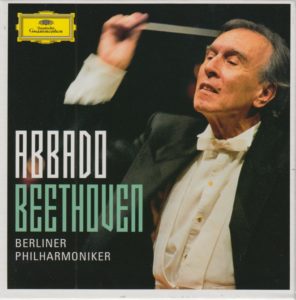
My listening post this morning is the Restaurant-Chain-That-Must-Not-Be-Named where two tables tables of self-important guys chat with unusually loud voices such that I can hear literally from across the room.
But that’s okay.
In my ears is Italian conductor Claudio Abbado (1933-2014), Berliner Philharmoniker, and the last symphony of my 162-day Beethoven project – Beethoven’s Symphony No. 9 in D minor.
So I can only see the guys’ lips flapping. Once I inserted the ear buds, their voices disappeared.
It’s still dark outside, even though it’s already 7:30.

Seriously, someone needs to remind me why I live in Michigan.
I start a brand new symphony today!
Therefore, as I always do when I start a new symmphony, here’s the poop on Beethoven’s Ninth, according to its entry on Wikipedia:
The Symphony No. 9 in D minor, Op. 125, is the final complete symphony by Ludwig van Beethoven, composed between 1822 and 1824. It was first performed in Vienna on 7 May 1824. One of the best-known works in common practice music, it is regarded by many critics and musicologists as one of Beethoven’s greatest works and one of the supreme achievements in the history of western music. In the 2010s, it stands as one of the most performed symphonies in the world.
The symphony was the first example of a major composer using voices in a symphony[5] (thus making it a choral symphony). The words are sung during the final movement by four vocal soloists and a chorus. They were taken from the “Ode to Joy”, a poem written by Friedrich Schiller in 1785 and revised in 1803, with text additions made by the composer.
In 2001, Beethoven’s original, hand-written manuscript of the score, held by the Berlin State Library, was added to the United Nations Memory of the World Programme Heritage list, becoming the first musical score so designated.
Music critics almost universally consider the Ninth Symphony one of Beethoven’s greatest works, and among the greatest musical works ever written.[1][2] The finale, however, has had its detractors: “[e]arly critics rejected [the finale] as cryptic and eccentric, the product of a deaf and aging composer.”
From an article on the NPR site,
The Ultimate Symphony
On a more purely musical level, perhaps no other piece of music has exerted such an impact on later composers. How, many wondered, should one write a symphony after the Ninth? Schubert, Berlioz, Brahms, Wagner, Bruckner, Mahler—the list goes on—all dealt with this question in fascinating ways that fundamentally affected the course of 19th-century music. Schubert, who apparently attended the premiere, briefly quoted the “joy” theme in his own final symphony, written the following year. Almost every Bruckner symphony begins in the manner of the Ninth—low string rumblings that seem to suggest the creation of a musical world. Mendelssohn, Mahler, and Shostakovich followed the model of a choral finale. Wagner was perhaps the composer most influenced by the Ninth, arguing that in it Beethoven pointed the way to the “Music of the Future,” a universal drama uniting words and tones, in short, Wagner’s own operas.
But composers were not the only ones to become deeply engaged with the Ninth, to struggle with its import and meaning. For more than a century, the work has surfaced at crucial times and places. As the ultimate “feel good” piece, the Ninth has been used at various openings of the Olympic Games, bringing all nations together in song. Its melody is the official anthem of the European Union. The Ninth has also appeared on many solemn occasions. Within recent memory, we may recall protestors playing the Ninth in Tiananmen Square in Beijing or German students doing so during the fall of the Berlin Wall. There were many performances in the wake of 9/11, when the Ninth was once again enlisted for its universal and hopeful message.
The NPR article is quite good. I urge you to pay it a visit.
For another viewpoint, The Atlantic offers an article with the improbable headline “What Does Beethoven’s Ninth Symphony Mean?”
The Ninth Symphony is arguably the single piece that inspired the methodology of musical analysis, a discipline of forensic musicological close-reading of the score that tried to prove just how unified and coherent a conception this symphony truly is underneath its chaotically diverse surface. It’s been held up as the central work of Western classical music both by those who imagine it as the ne plus ultra of symphonic, technical, and compositional imagination and mastery, and by those who want to say that classical music can embrace the world outside the concert hall as well as within it, and that the piece is a sounding bell of social change, of emotional hope, and even of political reform.
Also in The Atlantic article is a section called “Five key recordings,” from which comes this tidbit:
Wilhelm Furtwängler/Berlin Philharmonic Orchestra: maybe the most terrifying music-making that I know; a performance for Hitler’s birthday in 1942 that seethes with a daemonic intensity. The end sounds more like a scream of pain rather than a shout of joy.
Of course, the mere mention of such a recording is enough to kick me into overdrive as I try to track it down. A performance that historic is one I need to hear.
I believe I’ve found the best source online for this historic recording: Pristine Classical, a French company. I just paid $17 for a mono 24-bit FLAC download, complete with artwork. (Of course, then I had to convert it to mp3 to play in iTunes.)
You’re welcome.
I have encountered Maestro Abbado eight times previous to this morning, on…
 Day 1. Rating: None. [I have no idea why.]
Day 1. Rating: None. [I have no idea why.]
Day 19. Rating: “Meh!”
Day 37. Rating: “Meh!”
Day 55. Rating: “Huzzah!”
Day 73. Rating: “Meh!”
Day 91. Rating: “Huzzah!”
Day 109. Rating: “Huzzah!”
Day 127. Rating: “Huzzah!”
Not bad. Three “Meh!” and four “Huzzah!” ratings. (Plus one – the very first performance – no rating at all. Weird.)
Since this is a long symphony (approximately one hour), I doubt I’ll have a rating for today any time soon. I usually listen to a performance 2-3 times before I make a decision. And, in fact, I’ve already been at this for three hours. The first symphony of a new cycle always takes me a long time because I spend likely far too long researching and reading.
I do want to point out one of the most famous uses of Beethoven’s “Ode to Joy” segment in his Ninth – this scene from the classic movie Die Hard, which is often called a Christmas movie. Others say “It’s not Christmas until Hans Gruber falls off Nakatomi Plaza tower.”
I can’t argue with that.
Anyway this scene is as classic as the movie itself.
 Beethoven wrote his symphonies in four parts (except for the Sixth, which is in five). The time breakdown of this particular one (Symphony No. 9 in D minor), from this particular conductor (Abbado at 67) and this particular orchestra (Berliner Philharmoniker), at this particular time in history (April-May 2000) on this particular record label (Deutsche Grammophon) is as follows:
Beethoven wrote his symphonies in four parts (except for the Sixth, which is in five). The time breakdown of this particular one (Symphony No. 9 in D minor), from this particular conductor (Abbado at 67) and this particular orchestra (Berliner Philharmoniker), at this particular time in history (April-May 2000) on this particular record label (Deutsche Grammophon) is as follows:
I. Allegro ma non troppo, un poco maestoso………………….14:19
II. Molto vivace…………………………………………13:04
III. Adagio molto e cantabile……………………………..12:48
IV. Finale (A)………………………………………..5:38
IV. Finale (B) Chorale………………………………………..16:28
Total running time: 61:37
My Rating:
Recording quality: 4 (sounds nearly flawless to me; nice top end, very little ambient noises, only slight tape hiss )
Overall musicianship: 5 (totally into it, inspired, magical)
CD liner notes: 4 (liner notes consist of all necessary technical detail, plus an essay about Abbado’s approach to conducting Beethoven, translated into E/G/F/I, but virtually nothing about Beethoven himself or his symphonies)
How does this make me feel: 5 (“Huzzah!”)
I enjoyed the musical (non-singing) parts the most. As soon as I hit “part two” of the Finale (“Choral”), I started cringing. I dislike opera.
But I do recognize a beautify performance when I hear one.
I have no idea how to “rate” or assess a symphony this big, this grand, this iconic. Each movement is essential to the whole. And there are four movements of considerable length with which to contend.
This is a remarkable performance, with interesting passages scattered throughout.
I was carried away by the richness of Beethoven’s Ninth.
This is a fine performance of an exceptional symphony.
“Huzzah!”
NOTE: Beethoven was 54 when he finished Symphony No. 9 in D minor. He would live less than three more years. He died on 26 March 1827, nine months shy of his 57th birthday.
